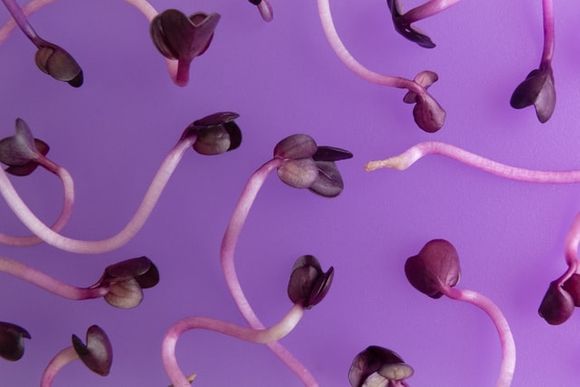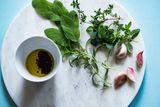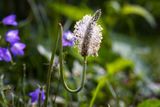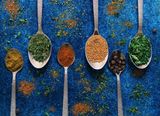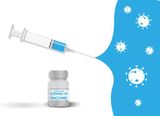Author: Rositsa Tashkova, Master of Molecular Biology and Microbiology
During germination, chemical processes occur in the seeds, which make macro- and microelements in them more accessible to our organism when consumed. It is similar to digestion.
Sprouts are rich in antioxidants and biologically active substances, they bring health benefits and enrich our diet. They are affordable, the seeds are cheap and easy to germinate at home. Sprouts may replace the need to take vitamins and minerals in the form of dietary supplements and pills.
Brown rice sprouts (Oryza sativa)
Brown rice sprouts are the most studied ones (white rice is the same plant, but with the hull removed). They have many benefits:
- improve blood sugar levels,
- correct blood lipid levels (cholesterol),
- have activity against oxidative stress and others.
These effects can not be attributed to a single bioactive compound, but rather to a synergistic interaction between all compounds induced by the germination process (i.e. GABA, oryzanol, phenols, dietary fiber, etc.), so their effect is greatest when sprouts are consumed whole rather than in the form of extracts. [ref.1]
Tatary buckwheat sprouts (Fagopyrum tataricum)
Tatary buckwheat is also known as green buckwheat, ku qiao, Tatar buckwheat, or bitter buckwheat. Its sprouts can be used for the preparation of pasta (containing 30% buckwheat sprouts and 70% durum wheat semolina) - its consumption has been found to reduce cardiovascular risk and metabolic disorders, such as hypertension in laboratory animals.
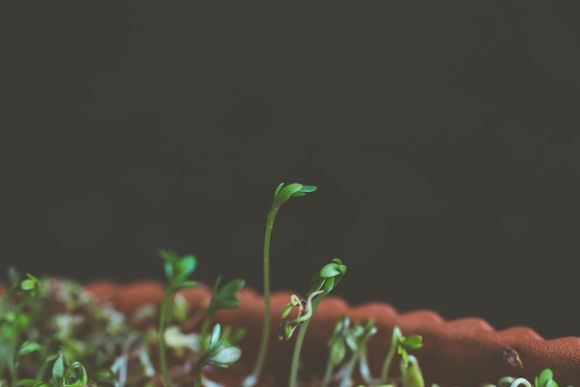
Fresh wheat leaves juice (Triticum aestivum)
The juice of the first green leaves of sprouted wheat is considered a superfood. It has been found that its intake by people suffering from thalassemia reduces the need and frequency of blood transfusions without negatively affecting hemoglobin levels.
The possibilities for use in the treatment of ulcerative colitis are also explored, since it has a high apigenin content.
This juice is rich in many healthy substances: iron, calcium, magnesium, vitamins A, C, E, K and B complex, etc.
It has an antioxidant, antibacterial and anti-inflammatory effect.
Broccoli sprouts (Brassica oleracea var. Italica)
Broccoli sprouts are rich in a variety of biologically active substances [ref.2]: the flavonoids quercetin and kaempferol, the phenolic acids synapine and ferrulic acid, glucosinolates and isotiocyanates.
These substances are associated with a decreased risk of cancer, degenerative diseases, metabolic disorders associated with obesity, suppression of allergic rhinitis/hay fever, decreased inflammation, pain suppression and antioxidant effects.
In human studies, broccoli sprouts have shown the ability to modulate inflammation and vascular events, suppress inflammation in those suffering from obesity and diabetes, regulate bowel functions in constipation.
Broccoli sprouts also have an impact on the skin. May provide protection against inflammation, swelling and carcinogens in humans.
It has been established that broccoli sprout extract can improve the condition of asthma sufferers.
They also showed an effect against the causative agent of gastric ulcer - Helicobacter pylori.

Turnip sprouts (Raphanus sativus)
Turnip sprouts also contain quercetin, ferulic, caffeic and p-coumaric acids, glucosinolates and the isothiocyanates sulforaphene, sulforaphane and indole-3-carbinol.
They lower the risk of cancer, heart disease, diabetes and have antioxidant activity.
Kale sprouts (Brassica oleracea var. acephala)
Kale sprouts contain quercetin and cyanidin, chlorogenic and ferulic acids and glucosinolates.
Their consumption is associated with a reduced risk of oncological and heart disease, a reduced risk of diabetes and high antioxidant activity.
Bok choy sprouts (Brassica rapa var. chinensis)
Bok choi sprouts, also known as pichay/petsay, or pok choi, contain kaempferol, quercetin, ferulic, caffeic and p-coumaric acids and glucosinolates.
Their consumption is associated with a reduced risk of cancer and heart disease, diabetes and have antioxidant activity.

Other seeds and nuts suitable for the preparation of sprouts
Many other seeds and nuts are suitable for germination and readily available:
- Peas, lentils, mung beans, soybeans;
- Wheat, oats;
- Beetroot, mustard seeds, clover;
- Sunflower, pumpkin seed, alfalfa, almond, sesame.
It is better to avoid the consumption of sprouts from kidney beans and quinoa, since they contain irritant substances and in some people have an adverse effect.
What to watch out for
Sprouts are very rich in nutrients. They can be consumed raw or lightly cooked, in salads and sandwiches. Therefore, it is important to wash the seeds as thoroughly as possible, as there is a risk of contamination with bacteria (e.g. E. coli and Salmonella) or parasites, which can make the consumption of raw sprouts dangerous.
When ingesting contaminated sprouts, the first symptoms appear after 12 to 72 hours: diarrhea, vomiting, abdominal pain.
This can be particularly dangerous for children, immunocompromised people, older people and pregnant women. It is recommended that they avoid consuming raw sprouts or sprouts at all.
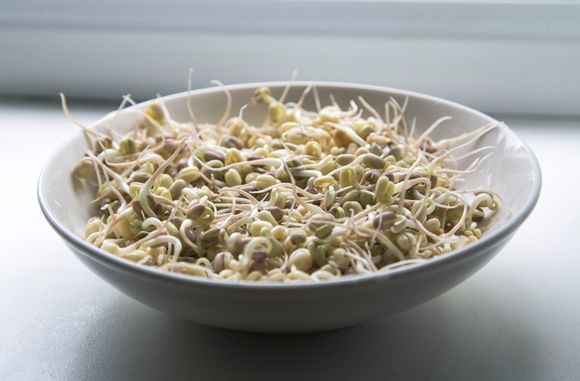
How to prepare sprouts at home
You need a large jar, a lid with holes, or gauze and an elastic band, instead of a lid. First, the seeds are soaked in cool water for several hours, depending on their type (most often 8 hours, but sesame and sunflower are soaked for 1 hour only). [ref.3]
Then the water is drained, the seeds are rinsed with fresh cool water, which is also drained away. Drain the seeds well, and the jar can be placed with the lid down and tilted to drain.
This rinsing and draining is repeated twice each day, until the desired length of the sprouts is reached.
It is not needed to put the jar in direct sunlight or in the dark.
When ready, rinse the sprouts one last time and distribute them on a paper tissue to dry. Otherwise, moisture will lead to their moulding. Then the sprouts can be stored for 2-3 days to 1 week in a box, paved with a clean cloth or paper against moisture retention.
If the sprouts develop mold, don't eat them! Discard them and try again.
Q&A
Do I need a special device or a machine to always have fresh sprouts at home?
As we described above, the process of producing sprouts at home is very easy and you do not need a special appliance or machine for this purpose. However, various appliances are available on the market which require compliance with the same steps - soaking the seeds and watering them with water twice a day or according to the indication. These appliances are also called a sprouting machine or system.
Where to buy sprouting seeds from?
You can buy seeds for germination from specialized seed stores, explicitly telling them for what purpose you buy the seeds (for germination and consumption of raw sprouts) or you can simply buy seeds and nuts from the local store (from here you can buy raw sunflower, almonds and much more).
Are there any special jars for germination, or can I use whatever I have?
Although you can safely use the jars available at home, special jars for the production of sprouts are also sold on the market. They have a suitable for draining cap, as well as a special stand to keep the jar in a position for better draining, while allowing proper airing of seeds and sprouts.
